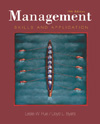 |  Management: Skills and Application, 10/e Leslie W Rue,
Georgia State University - Emeritus
Lloyd L Byars,
Georgia Institute of Technology
Controlling
Chapter Summary| 1. Explain why management controls are necessary. The overriding purpose of all management controls is to alert the manager to an existing or a potential problem before it becomes critical. Specifically, management controls can be used to (1) prevent crises, (2) standardize outputs, (3) appraise employee performance, (4) update plans, and (5) protect an organization's assets.
2. Describe a feedback system. Any system in which the outputs from the system affect future inputs or future activities of the system is called a feedback system; in other words, a feedback system is influenced by its own past behavior.
3. Discuss the basic requirements of the control process. The control process has three basic requirements: (1) establishing standards, (2) monitoring results and comparing them to standards, and (3) correcting for any deviations between the standard and actual results.
4. Describe the control pyramid. The control pyramid is a method for implementing control in the organization. It consists of control through foolproofing, automatic controls, operator controls, control by personal supervision, and informational controls.
5. Identify the factors that affect how much control should be exercised in an organization. When deciding how much control should be exercised in an organization, three major factors must be appraised: (1) economic considerations, (2) behavioral considerations, and (3) flexibility and innovation considerations.
6. Discuss the two categories of control methods. Control methods can be either of two kinds: (1) behavior control or (2) output control. Behavior (or personal) control is based on direct, personal surveillance. Output (or impersonal) control is based on the measurement of outputs.
7. Differentiate among preliminary, concurrent, and postaction controls. Preliminary (steering) controls are designed to prevent a problem from occurring. Concurrent (screening) controls focus on things that happen as inputs are being transformed into outputs. They are designed to detect a problem as it occurs. Postaction controls are designed to detect existing or potential problems after they occur but before they reach crisis proportions.
8. List several methods or systems of control commonly used by managers. Many control methods or systems are in use today. Some of the most popular control methods/systems include all types of budgets, financial controls (balance sheets, income statements, and financial ratios), direct observations, written reports, management information systems, audits, break-even charts, and time-related charts and techniques.
9. List the four basic types of financial ratios. The four basic types of financial ratios are profitability, liquidity, debt, and activity ratios.
10. Discuss the basic purpose of a break-even chart. A break-even chart graphically depicts the relationship of volume of operations to profits. |
|



 2003 McGraw-Hill Higher Education
2003 McGraw-Hill Higher Education